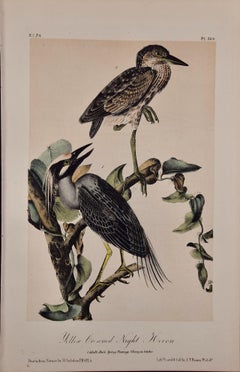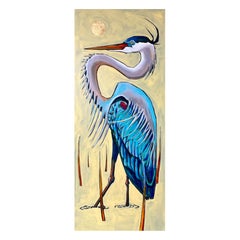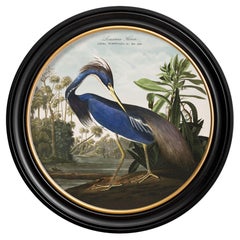James Heron
Snowy Heron /// John James Audubon Natural History Ornithology Snowy Egret Bird
By John James Audubon
Located in Saint Augustine, FL
Artist: John James Audubon (American, 1785-1851)
Title: "Snowy Heron" (Plate 374, No. 75)
Portfolio
Category
1840s Victorian Animal Prints
Materials
Watercolor, Lithograph
Large Classical Bird Color Print After John James Audubon, Louisiana Heron
Located in Cirencester, GB
Classical Bird print,
after John James Audubon,
printed by Harry N. Abrams, Publishers, New
Category
20th Century Victorian Prints
Materials
Other
$189
H 17 in W 14 in D 1 in
Night Heron Birds: An Original 19th C. Audubon Hand-colored Bird Lithograph
By John James Audubon
Located in Alamo, CA
This is an original John James Audubon hand-colored lithograph entitled "Yellow Crowned Night Heron
Category
Late 19th Century Naturalistic Animal Prints
Materials
Lithograph
$1,075
H 10.25 in W 6.75 in
Great Blue Heron, James Mattison, 24x60, Oil and Gold Leaf on Wood Canvas, 2024
Located in Deland, FL
James Mattison (1990) is a self-taught fine artist focusing on contemporary impressions of people
Category
2010s American Organic Modern Paintings
Materials
Canvas, Paint
$12,995
H 60 in W 24 in D 0.75 in
Louisiana Heron Print from Audubon's Birds of America C1838 in Round Frame, New
By John James Audubon
Located in Lincoln, Lincolnshire
This is a digitally remastered print of a Louisiana Heron referenced from an Audubon Birds of
Category
2010s British American Colonial Prints
Materials
Glass, Wood, Paper
$483
H 1.58 in Dm 27.56 in
Recent Sales
Louisianna Heron, Edition Pl. 217
By After John James Audubon
Located in Mount Vernon, NY
Oppenheimer and the Field Museum in 1999. This collection includes fifty best watercolor birds by John James
Category
1990s Naturalistic Animal Prints
Materials
Lithograph
"Great White Heron" After Audubon Chromolithograph, from the 1860 Bien Edition
By After John James Audubon
Located in New York, NY
After John J. Audubon Great White Heron chromolithograph from "The Birds of America", 1860 Bien
Category
1860s American Realist Animal Prints
Materials
Lithograph
After James Audubon "Snowy Heron" Print
Located in Astoria, NY
After John James Audubon (French/American, 1785-1851), "Snowy Heron or White Egret", Print on Paper
Category
Early 20th Century American Other Prints
Materials
Paper
Audubon White Heron Plate #386 Havell
By John James Audubon
Located in Rio Vista, CA
Large original sized Audubon chromolithograph "White Heron" plate #386. Oppenheimer edition of only
Category
20th Century American American Classical Prints
Materials
Steel
Little Green Heron Bird Block Print
By James McConnell (Mac) Anderson
Located in Houston, TX
Woodblock print of a little green heron bird in the water among tall grass by James Mac Anderson in
Category
1980s Modern Animal Prints
Materials
Woodcut
H 16.75 in W 13.5 in D 0.75 in
Great White Heron 1860 Audubon Bien Edition Original Chromolithograph
By John James Audubon
Located in Paonia, CO
Great White Heron( Ardea occidentalis. ) Pl. 368 .double-elephant chromolithograph 1860 by
Category
1860s Animal Prints
Materials
Lithograph
Large Classical Bird Color Print After John James Audubon, Great Blue Heron
Located in Cirencester, GB
Classical Bird print,
after John James Audubon,
printed by Harry N. Abrams, Publishers, New
Category
20th Century Victorian Prints
Materials
Other
Loch Ard from Aberfoyle - 19th Century Scottish Landscape Oil Painting
Located in Gerrards Cross, GB
‘Loch Ard from Aberfoyle’ by James Heron (1848-1919).
A large fine 19th century oil painting
Category
Late 19th Century Impressionist Landscape Paintings
Materials
Oil
John James Audubon 'Purple Heron'-
By John James Audubon
Located in Brooklyn, NY
Paper Size: 26.25 x 39.25 inches ( 66.675 x 99.695 cm
Image Size: 22.5 x 34.25 inches ( 57.15 x 86.995 cm )
Framed: No
Condition: A-: Near Mint, very light signs of handling
Shippin...
Category
Late 20th Century Contemporary Prints and Multiples
Materials
Offset
Limited Edition John James Audubon Snowy Heron or Egret Lithograph, Princeton
By John James Audubon
Located in Lambertville, NJ
Large limited edition Heron or White Egret Bird Audubon fine art lithograph plate. This Princeton
Category
Vintage 1980s Prints
Materials
Glass, Wood, Paper
H 34.25 in W 27.25 in D 1 in
Large Classical Bird Color Print after John James Audubon - Louisiana Heron
By After John James Audubon
Located in Cirencester, Gloucestershire
Classical Bird print,
after John James Audubon,
printed by Harry N. Abrams, Publishers, New York
Category
20th Century Victorian Animal Prints
Materials
Color
Large Classical Bird Color Print after John James Audubon - Great Blue Heron
By After John James Audubon
Located in Cirencester, Gloucestershire
Classical Bird print,
after John James Audubon,
printed by Harry N. Abrams, Publishers, New York
Category
20th Century Victorian Animal Prints
Materials
Color
Louisiana Heron: An Original 19th C. Audubon Hand-colored Bird Lithograph
By John James Audubon
Located in Alamo, CA
This is an original John James Audubon hand-colored lithograph entitled "Louisiana Heron, Male
Category
Late 19th Century Naturalistic Animal Prints
Materials
Lithograph
Snowy Heron, or White Egret, Edition Pl. 242
By After John James Audubon
Located in Mount Vernon, NY
Oppenheimer and the Field Museum in 1999. This collection includes fifty best watercolor birds by John James
Category
1990s Naturalistic Animal Prints
Materials
Lithograph
Yellow-Cowned Heron, Edition Pl. 336
By After John James Audubon
Located in Mount Vernon, NY
Oppenheimer and the Field Museum in 1999. This collection includes fifty best watercolor birds by John James
Category
1990s Naturalistic Animal Prints
Materials
Lithograph
Pair of James J. Audubon Framed Lithographs First Octavo Edition, 1843
By John James Audubon
Located in Stamford, CT
Pair of Framed James J. Audubon Lithographs. Snowy Heron Print No. 75 Pl. 374; Wood Ibis Print No
Category
Antique Mid-19th Century American Prints
Materials
Paper, Wood
H 15.75 in W 12.75 in D 0.75 in
Custom Listing : Tami 8 Pieces
By After John James Audubon
Located in Mount Vernon, NY
. 261
2) After John James Audubon, Snowy Heron, or White Egret, Edition Pl. 242
3) After John James
Category
1990s Naturalistic Animal Prints
Materials
Lithograph
People Also Browsed
American Flamingo /// John James Audubon Natural History Ornithology Bird Litho
By John James Audubon
Located in Saint Augustine, FL
Artist: John James Audubon (American, 1785-1851)
Title: "American Flamingo" (Plate 375, No. 75)
Portfolio: The Birds of America, First Royal Octavo Edition
Year: 1840-1844
Medium: Or...
Category
1840s Victorian Animal Prints
Materials
Watercolor, Lithograph
American Anhinga - Snake Bird /// John James Audubon Ornithology Natural History
By John James Audubon
Located in Saint Augustine, FL
Artist: John James Audubon (American, 1785-1851)
Title: "American Anhinga - Snake Bird" (Plate 420, No. 84)
Portfolio: The Birds of America, First Royal Octavo Edition
Year: 1840-184...
Category
1840s Victorian Animal Prints
Materials
Watercolor, Lithograph
Pair of Vintage Hand Forged Wrought Iron Dragon Andirons from France
Located in San Francisco, CA
Uniquely French, these wrought iron "fire dragons" are great as decor in your fireplace, with or without the burning flames. With today's eclectic and layered interiors, the Gothic d...
Category
Early 20th Century French Gothic Revival Andirons
Materials
Wrought Iron
$2,000 / set
H 12.2 in W 7.5 in D 24.5 in
Male Whooping Crane: An Original 19th C. Audubon Hand-colored Bird Lithograph
By John James Audubon
Located in Alamo, CA
This is an original John James Audubon hand-colored 1st octavo edition lithograph entitled "Whooping Crane, Male, adult", No. 63, Plate 313 from Audubon's "Birds of America, lithogra...
Category
Mid-19th Century Naturalistic Animal Prints
Materials
Lithograph
Reddish Egrets, Adult & Young: An Original Audubon Hand-colored Bird Lithograph
By John James Audubon
Located in Alamo, CA
This is an original John James Audubon hand-colored lithograph entitled "Reddish Egret, 1. Adult, Full Spring Plumage 2. Young in Full Spring Plumage Two Years Old", No. 75, Plate 37...
Category
Mid-19th Century Naturalistic Animal Prints
Materials
Lithograph
$1,775
H 6.75 in W 10.25 in
Mango Hummingbirds: An Original 19th C. Audubon Hand-colored Bird Lithograph
By John James Audubon
Located in Alamo, CA
This is an original John James Audubon hand-colored lithograph entitled "Mango Humming bird, 1. 2. Males. 3. Female. Bignonia grandifolia", No. 51, Plate 251 from Audubon's "Birds of...
Category
Late 19th Century Naturalistic Animal Prints
Materials
Lithograph
John James AudubonMango Hummingbirds: An Original 19th C. Audubon Hand-colored Bird Lithograph, 1870
$1,575
H 10.25 in W 6.75 in
Bonaparte’s Flycatching-Warbler (Great Magnolia) /// Ornithology Bird Audubon
By John James Audubon
Located in Saint Augustine, FL
Artist: John James Audubon (American, 1785-1851)
Title: "Bonaparte’s Flycatching-Warbler (Great Magnolia)" (Plate 73, No. 15)
Portfolio: The Birds of America, First Royal Octavo Edit...
Category
1840s Victorian Animal Prints
Materials
Watercolor, Lithograph
Brown Pelican: An Original Audubon 1st Edition Hand-colored Bird Lithograph
By John James Audubon
Located in Alamo, CA
This is an original rare and extremely collectible first octavo edition John James Audubon hand colored lithograph entitled "Brown Pelican, Young First Winter", No. 85, Plate 424, fr...
Category
Mid-18th Century Naturalistic Animal Prints
Materials
Lithograph
Phalacrocorax Graculus (Spectacled Cormorant) /// John Gould Ornithology Bird
By John Gould
Located in Saint Augustine, FL
Artist: John Gould (English, 1804-1881)
Title: "Phalacrocorax Graculus (Spectacled Cormorant)" (Vol. 5, Plate 53)
Portfolio: The Birds of Great Britain
Year: 1862-1873
Medium: Origin...
Category
1860s Victorian Animal Prints
Materials
Watercolor, Lithograph
$1,400
H 21.63 in W 14.75 in
Black-billed Cuckoo: An Original 1st Ed. Audubon Hand-colored Bird Lithograph
By John James Audubon
Located in Alamo, CA
This is an original 1st octavo edition John James Audubon hand-colored lithograph entitled "Black-billed Cuckoo, 1. Male, 2, Female, Magnolia Grandiflora", No. 56, Plate 276 from Aud...
Category
Mid-19th Century Naturalistic Animal Prints
Materials
Lithograph
"American Swan", Audubon Hand-colored First Octavo Edition Lithograph
By John James Audubon
Located in Alamo, CA
This is an original rare and extremely collectible 1st royal octavo edition John James Audubon hand-colored royal octavo lithograph entitled "American Swan", No. 77, Plate 384, from ...
Category
Mid-19th Century Naturalistic Animal Prints
Materials
Lithograph
$2,375
H 6.63 in W 10.13 in
Florida Cormorant /// John James Audubon Ornithology Bird Art Natural History
By John James Audubon
Located in Saint Augustine, FL
Artist: John James Audubon (American, 1785-1851)
Title: "Florida Cormorant" (Plate 417, No. 84)
Portfolio: The Birds of America, First Royal Octavo Edition
Year: 1840-1844
Medium: Or...
Category
1840s Victorian Animal Prints
Materials
Watercolor, Lithograph
"Washington Sea Eagle": An Original Audubon Hand-colored Lithograph
By After John James Audubon
Located in Alamo, CA
This is an original John James Audubon hand-colored royal octavo lithograph entitled "Washington Sea Eagle", No. 3, Plate 13, from Audubon's "Birds of America". It was lithographed, ...
Category
Mid-19th Century Naturalistic Animal Prints
Materials
Lithograph
Rare Victorian Firescreen with Taxidermy Hummingbirds by Henry Ward
By Henry Ward
Located in Amsterdam, NL
England, third quarter of the 19th century
On two scrolling foliate feet with casters, above which a rectangular two-side glazed frame, with on top a two-sided shield with initial...
Category
Antique Mid-19th Century English High Victorian Taxidermy
Materials
Other
$234,499 Sale Price
33% Off
H 51.19 in W 55.12 in D 201.58 in
"Esquimaux Curlew": A Framed Original Audubon Hand-colored Folio Engraving
By John James Audubon
Located in Alamo, CA
This is an original hand-colored folio edition John James Audubon engraving entitled "Esquimaux Curlew", Folio, Pl. CCVIII", No. 42, Plate 208, from Audubon's "Birds of America". It ...
Category
Mid-19th Century Naturalistic Animal Prints
Materials
Engraving
$3,775
H 23.25 in W 28.38 in D 0.75 in
Red-cockaded Woodpecker: A First Octavo Edition Audubon Hand-colored Lithograph
By John James Audubon
Located in Alamo, CA
This is an original John James Audubon hand-colored royal first octavo edition lithograph entitled "Red-cockaded Woodpecker, 1. 2. Male, 3. Female", No. 53, Plate 264, from Audubon's...
Category
Mid-19th Century Naturalistic Animal Prints
Materials
Lithograph
Get Updated with New Arrivals
Save "James Heron", and we’ll notify you when there are new listings in this category.
James Heron For Sale on 1stDibs
Find the exact james heron you’re shopping for in the variety available on 1stDibs. Find Modern versions now, or shop for Modern creations for a more modern example of these cherished works. You’re likely to find the perfect james heron among the distinctive items we have available, which includes versions made as long ago as the 19th Century as well as those made as recently as the 20th Century. If you’re looking to add a james heron to create new energy in an otherwise neutral space in your home, you can find a work on 1stDibs that features elements of beige, brown, gray, white and more. Creating a james heron has been a part of the legacy of many artists, but those crafted by John James Audubon and James McConnell (Mac) Anderson are consistently popular. Artworks like these — often created in lithograph, oil paint and paint — can elevate any room of your home.
How Much is a James Heron?
The price for an artwork of this kind can differ depending upon size, time period and other attributes — a james heron in our inventory may begin at $1,200 and can go as high as $13,000, while the average can fetch as much as $2,630.
More Ways To Browse
Mid Century Cabinet Handles
Vintage Cabinet Door Handles
Modernist Cabinet
Vintage Black Door Handles
Round Door Handles
Used Privacy Screens
Carved Bird Panel
Chinese Screens Carved Wood
Vintage Black Lacquer Cabinet
Round Column Cabinets
Swivel Cabinet
Vintage Carved Wood Bear
Painted Panel Screen Birds
Chinese Screen With Birds
Modernist Door Handles
Chinese Four Panel Screen
Pineapple Wood
Birds Folding Screen





